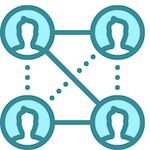I spent time in prison, a long time ago.
Before you get nervous, let me explain.
I studied psychology and criminology. As part of my criminology degree, I worked on a program called “Scared Straight” with my professors.
We took young criminals (males between the ages of 18-24) into the Anamosa State Penitentiary, a maximum-security prison, located in eastern Iowa.
Criminal researchers and practitioners believed that when young criminals saw what prison life was like, it would be so unpleasant that they would change their ways. Robbing small stores, stealing cars and carrying an unlicensed firearm were some of their offences.
It was a tough setting, six to eight prison inmates, sitting in a circle with me, my professor, and some not so seasoned, young criminals. In each corner of the room, a prison guard stood with a high-powered rifle, ready to neutralize situations that escalated. The older men (many of them in for life sentences) taunted the young criminals with a lot of profanity. They told these young men to change their ways before it was too late.
The program had measurable success, when one important distinction took place.
As profound as these experiences were, many of the men went back into the environments they came from. Back to an environment of drugs, violence, gangs and few of them had both parents at home. These young men returned quickly to their old habits. Some of them were fortunate, however, and placed in foster homes, away from their old neighborhood, old connections and old habits.
Those in new environments did vastly better, stayed out of trouble much better than the group that “returned home”.
My Anamosa prison experience has helped me recognize what must go right, and what can go wrong when supporting leaders to play at their best. I will say more about that in the last segment of this month’s news2use.
Enjoy your read!
Dan
“Relevant & pragmatic ideas, tools and insights to play at your best.”

For You
Managing information during negotiations can make or break your results. As individual negotiators or as a team that negotiates complex agreements for your business, being clear about what you want, what you share, and what you do not share, is critical to your negotiation outcomes. Here is a tool to help you and your team manage information effectively during negotiations.

I have used this planning tool for years. It is called an Information Matrix. Here is how it works:
Quadrant I is the GIVE quadrant. This is information that you intend to give to the other party that could lead to a good agreement for both of you.
Quadrant II is the GET quadrant. This is information that you want to get from the other party. Good negotiating teams create questions and determine who will ask what question in advance of the actual negotiation.
Quadrant III is the KEEP quadrant*. This is information that you have decided to keep to yourself or within your team.
Quadrant IV is the SURPRISE quadrant*. This is information that comes to you during the negotiation that you did not plan for, or that surprises you.
This planning tool, used in advance of your negotiations, helps you organize what and how you want to exchange with your negotiation counterparts. Well-prepared negotiators perform better than those who are unprepared.
*If you accidently give information away that you agreed to keep, or get something that fits in the SURPRISE quadrant (something you did not plan for), take an adjournment or a break to see what this means to your negotiation process.
Negotiations are dynamic experiences and there is nothing wrong with taking a break to realign your strategy or to stabilize a situation.

For You & Your Team
Picture a bank, with a walk-in ATM lobby. When you walk into the ATM area and look between the ATMs, you find cash. A great deal of cash, stuck between the ATM machines.
Where is this bank, you ask?
Imagine that those ATMs represent the different functions of your business, where you create value. At least this is what many people who work in their function think. Often individual functions think they are the most important folks in world and the heck with the others, and that often includes the customer.
None of us wants to leave cash between the ATMS, yet this is what happens when we allow business functions to fence off their area (and fall into silo mentalities) and not collaborate generously with their functional colleagues.
An executive team last week shared that they have two senior leaders reporting into them from the same country who will not communicate with each other. They work in the same business market and they should work together, but this only happens when both communicate through the Frankfurt headquarters. Then Frankfurt feeds back to each of them what the other one is doing.
It is hard to say what is more damaging, the behavior of the two leaders in the local market or the “passive acceptance” of the HQ leadership.
In either case, it is emotionally draining and wasting resources.
Business functions have slightly different priorities that can lead to alignment issues and friction. This is a normal experience in every organization. The distinction between those businesses that struggle and those that thrive is the priority and effort they place on collaborative excellence. Simply put, a high performance organization does not tolerate dysfunctional collaborations over time.
Here is how to optimize cross-functional collaborations:
- Map the key collaborations in your business. Do this for both internal and external collaborations.
- Identify high quality collaborations and replicate best practices.
- Clarify sub-optimal collaborations. Hold the appropriate stakeholders accountable for resolution or transformation within a specified time.
- Practice cross-functional complimenting. It is powerful and shows people that you notice their efforts.
- Speak with your key collaboration partners. Use questions like, “How can we help you be more successful and what is it like to work with us?”
Make collaboration excellence a priority for your business. Look at it like cash between the ATMS. You would not leave money between the ATMS, so do not leave it between your functions either.

For You, Your Team & Your Business
My Anamosa prison experience reinforces how futile individual change efforts are if the environment does not change.
Taking leaders out of their team and out of their environment for individual development is not the best way to improve leadership performance and will not have any impact on your organization results.
Leadership development should and must take place as a team experience.
This is why I believe that we should not coach leaders in isolation. Sending a coached leader back into an uncoached team will not be as impactful as the leader and her entire team learning, improving and committing to change together.
We need to distinguish between leader development, that is support for an individual leader and leadership development, which involves the leader and her team.
Individual leader development can support behavioral or skills issues for individuals, but only leadership development, as a team, can improve both leadership performance and improving organizational results.
More emphasis on leadership as a team endeavor will create competitive advantage over those organizations that continue to view leadership as a solo or individualistic experience.
People, Places & Technology
What is your biggest challenge when it comes to digital transformation?
Executives say it is not the technology they struggle with; it is finding and hiring the right people.
People like you need leaders and experts with digital DNA, who deeply understand the potential of digitalization, who are able to develop a true digital strategy and then make it happen.
I have had several exchanges with Sasha Frank, Managing Director of espiridon. They are professional and mission-driven, dedicated to helping you find the right digital talent.
espiridon has been placing professionals in digital positions for over ten years. Its list of clients includes global players as well as small and medium-sized German companies.
Here is a link to espiridon’s home page, feel free to contact Sasha or his team if you would like to find the right talent to lead and support your digital transformation.
Thought for the Day
To become the instruments of a great idea is a privilege
that history gives only occasionally. -Arnold Toynbee
